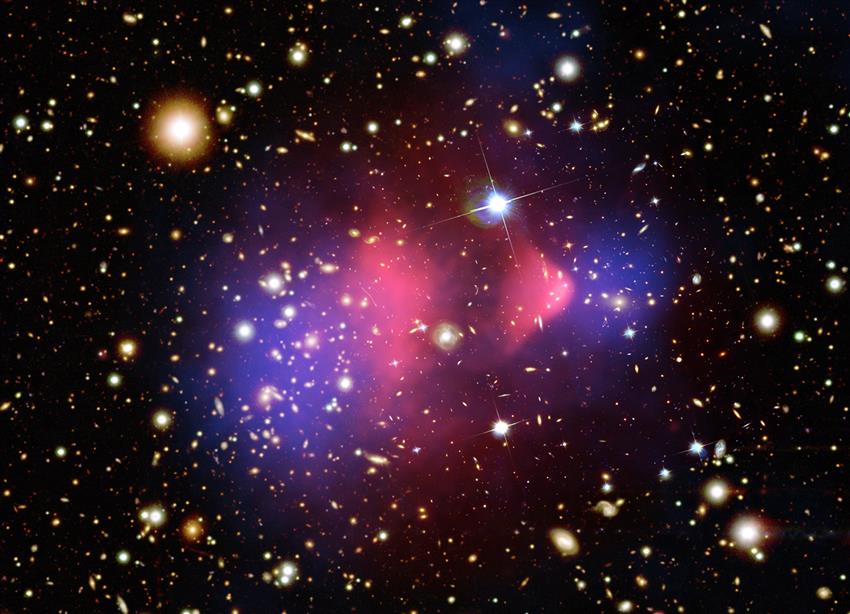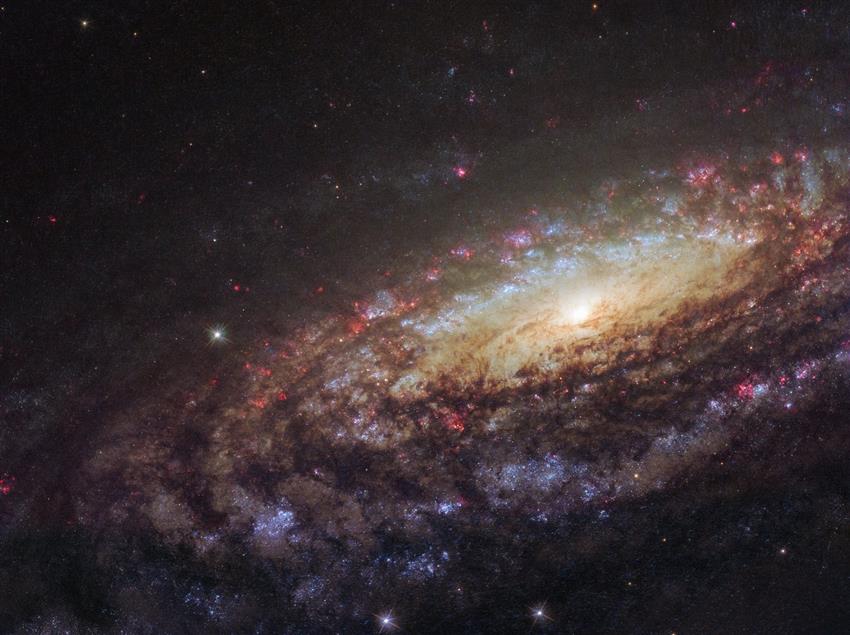The mysteries of dark matter and dark energy
The more we explore the universe, the more we realize just how many discoveries await us. Scientists now believe that regular matter – what makes up humans, plants, everyday objects, planets and even stars – only accounts for about 4 percent of all the stuff in the universe. The other 96 percent is made up of dark matter and dark energy, which does not interact with light and can only be detected from its effects. Details about the properties of dark matter and dark energy remain some of the biggest mysteries of modern astronomy.
Hunting for dark matter

This is a composite image of the Bullet Cluster, a galaxy cluster made up of several smaller clusters of galaxies, about 3.4 billion light-years away from Earth. The image includes three important elements: visible light (stars and galaxies in white and orange) gathered by Hubble and the Magellan Telescope; pink areas where the Chandra X-ray Observatory detected hot gas, which contains most of the "normal" matter in the clusters; and blue areas, where astronomers find the most mass in the clusters. The fact that the pink and blue regions do not line up indicates that most of the gravitational mass is not found in the visible structures or the hot gas – in fact, most of the mass of the galaxy cluster exists in clumps of invisible dark matter that does not interact with light at all. (Credit: NASA/CXC/M. Markevitch et al./STScI/Magellan/UArizona/D. Clowe et al./ESO WFI)
Astrophysicists have hypothesized that the universe contains some kind of "dark matter" – a form of matter that does not interact with the electromagnetic field, not absorbing, emitting, or reflecting any form of light. Scientists noticed that galaxies were moving around in their groups and clusters much faster than predicted. This increased speed meant that the clusters had to contain more matter than what could be seen in order for their gravity to keep holding the galaxy clusters together.
In the 1960s and 1970s, astronomers such as Vera Rubin studied the movement of stars and gases orbiting spiral galaxies. They measured the total mass found inside these galaxies. When comparing this total mass with the amount of luminous mass (such as stars and gas) found in galaxies, they realized that a lot of matter was missing! Their work showed that galaxies contain about six times more of this mysterious "dark matter" than normal matter. Scientists now think that dark matter makes up about a quarter of all the matter and energy in the universe.
By applying Newton's laws of motion and gravity to the motion of stars and gases in a galaxy, astronomers can measure the distribution of mass in a galaxy. The measured mass often greatly exceeds that from visible matter, suggesting the presence of dark matter.
Dark matter candidates

The Dark matter Experiment using Argon Pulse-shape discrimination (DEAP) project is located two kilometres underground in the SNOLAB facility near Sudbury, Ontario. An international team of scientists is using DEAP to try to detect weakly interacting massive particles, a strong candidate for dark matter. (Credit: The DEAP-3600 Collaboration)
Scientists have thought of many explanations for what dark matter could be. Black holes were suggested since they don't emit light. Since they are quite dim, brown dwarfs and large planets were also a possibility. Based on the known characteristics of these objects, it is unlikely that enough of them exist to account for all the dark matter present in the universe.
Most scientists now believe that dark matter is likely made up of something very small. The leading candidate is a hypothetical unit called a weakly interacting massive particle (WIMP). This type of particle would interact with the force of gravity and the weak nuclear force, but not the electromagnetic force, meaning it would not emit, absorb or reflect light – a match for the behaviour currently observed with dark matter.
In order to learn more about these invisible particles, scientists around the world are building large detectors filled with materials they hope will interact with dark matter. Because researchers want the detectors to only detect dark matter particles, these experiments are often placed deep underground where Earth's crust can shield them from any possible interference.
Dark energy: unlike anything else

An image of supernova SN 2011fe in the Pinwheel Galaxy taken by the Palomar Observatory in California. (Credit: BJ Fulton/LCOGT)
Dark matter and dark energy are often mentioned together. Unlike dark matter, which appears to share some qualities with regular matter, dark energy seems to be a force unlike anything else in the cosmos – and it makes up about 70 percent of everything in the universe.
The universe has been expanding since the Big Bang. Astronomers can study this expansion by measuring how quickly very distant galaxies are moving away from us. Some supernova explosions can be used to measure the increasing distances between galaxies. Researchers recently discovered that the universe is actually growing faster than expected! Dark energy may be behind this increase – the hypothetical, unknown force may be pushing against the boundaries of the universe, like an anti-gravity. Dark energy remains an important topic of scientific research, as very little is known about its properties.

